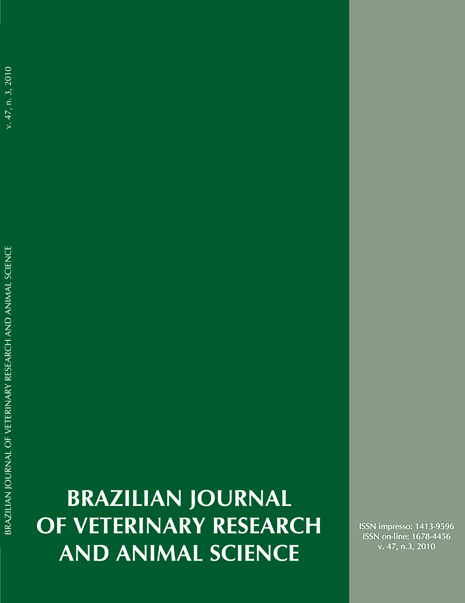Anti-Leptospira spp. antibodies in wild animals from Ribeirão Preto city zoo in São Paulo State, Brazil
DOI:
https://doi.org/10.11606/issn.1678-4456.bjvras.2010.26862Keywords:
Leptospirosis, Wild animals, Zoo. SerovarsAbstract
Leptospirosis may affect all domestic and wild animals as well as human beings. Some serological studies have shown the involvement of wild species in the epidemiology of the disease. Once captive wild animals are not much studied, especially in Brazil, the present study aimed to detect anti- Leptospira spp. antibodies in animals from Ribeirão Preto city zoo, in São Paulo state, Brazil. Blood samples were collected from captive birds, fish, reptiles and mammals, sinanthropics and free-living animals and also from employees between March and October, 2006. Four hundred and three blood samples were obtained, 388 animals' samples (110 reptiles, 143 birds, 110 mammals and 25 fish) and 15 humans'. The sera were analysed by Microscopic Agglutination Test using 22 serovars from pathological leptospiras and two from non-pathological serovars. Among the animal samples, 339 were from captive animals, and 49 from free-living ones, captured with traps inside the zoo. One hundred and three (103/388 = 26.5%) samples reacted to leptospirosis, ninety-two (92/339 = 27.1%) samples were from captive animals and eleven (11/49 = 22.4%) from free-living ones. All humans' samples were negative. Serological titles varied from 40 to 5.120, with predominance of titles between 40 and 80 and the most frequent serovars were Patoc, Andamana, Canicola, Icterohaemorrhagiae and Panama.Downloads
Download data is not yet available.
Downloads
Published
2010-06-01
Issue
Section
UNDEFINIED
License
The journal content is authorized under the Creative Commons BY-NC-SA license (summary of the license: https://
How to Cite
1.
Silva C dos S, Gírio RJS, Guerra Neto G, Brich M, Santana LA de S, Amâncio FH, et al. Anti-Leptospira spp. antibodies in wild animals from Ribeirão Preto city zoo in São Paulo State, Brazil. Braz. J. Vet. Res. Anim. Sci. [Internet]. 2010 Jun. 1 [cited 2024 Apr. 16];47(3):237-42. Available from: https://www.revistas.usp.br/bjvras/article/view/26862





